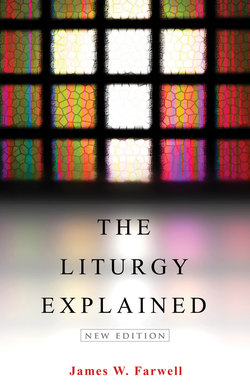Читать книгу The Liturgy Explained - James W. Farwell - Страница 7
ОглавлениеThe Sacred Geography of the Liturgy
f the liturgy involves embodiment of a way of being in the world—grateful, compassionate, relying on God for our life and well-being, etc.—and bodies move in space, then we should include in our explanation of the liturgy a few words about the space in which liturgy occurs. Most rituals either occur in sacred space, or make sacred the space in which they occur, often both. The Eucharistic liturgy typically occurs in a church, a term that really means the people of God (from a Greek term meaning “the Lord’s”), but a word we now tend to use for the physical space in which the liturgy is done. Space too, like the liturgy as a whole, enacts what it means to be Christian.
There is a great variety of spaces in which the liturgy occurs. We will not even begin to attempt to describe the differences among the many architectural styles of churches in East or West, but we can say something about the centers of the sacred space. Those centers are the key to the sacred geography of the liturgy, even though the centers are themselves arranged in various ways within the room.
The centers of liturgical space are three: the place where the Scriptures are read, the place where new members of the community of faith are initiated, and the place where the community gathers to eat its sacred food. In short, the centers of the sacred geography are the Ambo, the Font, and the Table. The liturgy not only occurs within them but reinforces their significance in the process.
The Ambo is the place from which the Scriptures are read and, perhaps, the sermon is preached. In some churches, particularly those built in recent years, the Ambo is a single lectern, podium, or standing desk; in older churches, there will often be more than one such piece of furniture that serve together as this liturgical center. Perhaps the Scriptures will be read from one and the sermon delivered from the other. Since the hearing of the Word and the preaching of the Word are linked, we will talk about the Ambo here in the singular.
The Ambo stands in the midst of the people, a symbol of Christian life as marked by responsiveness to God. We are hearers of the Word, listening in our sacred texts for the Word of God to be spoken: calling, coaxing, commanding, instructing, encouraging, judging, renewing. Some Christians—only a few, historically speaking, and restricted largely to the modern era—take the Bible literally. For most Christians the Bible is the Word of God in human words. Strictly speaking, Jesus alone is the Word of God, in whose life we witness the gracious call to a transformed life of gratitude and care for others, and the forgiveness of sin. Yet it is the Bible that speaks of Jesus as the Word, and so the Bible is the Word of God because it bears witness to that Word who is Jesus Christ, and it reveals God’s care and call to us. Christians do not simply direct their own lives and destinies but orient themselves toward God as those who listen, receive, and obey the commands of God as the law of life, the outlines of a life well lived, the path to human flourishing as God intends for us.
The Font is linked to the Word, as in fact all three of the centers are to each other. The Font is the receptacle that holds the water by which new members of the community of God-followers are initiated. Some are small and off to the side, but increasingly churches have returned to an older pattern in which the font is prominent, linked spatially to Word and Table, or perhaps placed by the door as a reminder to all that it is by their baptism that they have been incorporated into the community that knows itself as the very Body of Christ. In baptism, water is poured over the heads or bodies of initiates, and the rich ambiguity of water is key to the ritual. Water cleanses and waters drowns; water washes the earth clean and, in great amounts, destroys; water refreshes, and renews. The ambiguity of water is an appropriate symbol, then, for Christian initiation: those who enter into a life lived before God through Jesus Christ die to an old life and awaken to new life, true life, by God’s Word; they are refreshed and renewed and made clean not by their own doing, but by God whose radical love and forgiveness is freely offered to all. Being forgiven and reborn, they commence a life in which they promise to celebrate in gratitude the life they have been given; trust in God; be faithful members of the church that testifies to God’s grace by its mission and outreach to the world; care for the dignity of all human beings who are made in God’s image; and return again, with the help of God, whenever they fail to keep these promises.
The Table, or Altar, is the place where the community of faith, baptized into this life of responsive trust, gratitude, and compassionate care for God’s world is strengthened daily to continue that work by the presence of the risen Lord Jesus, who commanded that his followers share this meal to remember him. At the same time, eating the sacred food, we become what we eat. (Remember Augustine’s teaching at the end of the last chapter.) Since the focus of this book is on the Eucharist, a ritual that culminates in this sacred eating, we will have much more to say on this in subsequent sections.
